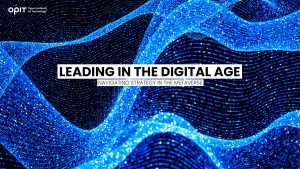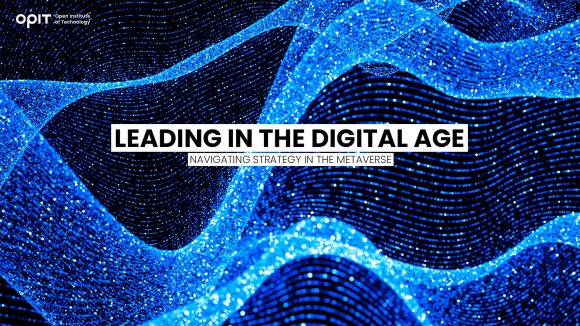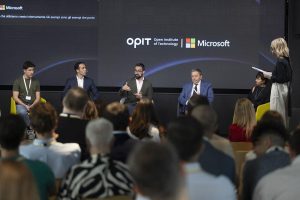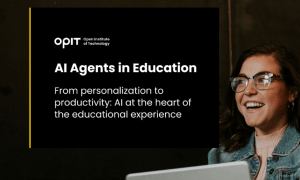

In April 2025, Professor Francesco Derchi from the Open Institute of Technology (OPIT) and Chair of OPIT’s Digital Business programs entered the online classroom to talk about the current state of the Metaverse and what companies can do to engage with this technological shift. As an expert in digital marketing, he is well-placed to talk about how brands can leverage the Metaverse to further company goals.
Current State of the Metaverse
Francesco started by exploring what the Metaverse is and the rocky history of its development. Although many associate the term Metaverse with Mark Zuckerberg’s 2021 announcement of Meta’s pivot toward a virtual immersive experience co-created by users, the concept actually existed long before. In his 1992 novel Snow Crash, author Neal Stephenson described a very similar concept, with people using avatars to seamlessly step out of the real world and into a highly connected virtual world.
Zuckerberg’s announcement was not even the start of real Metaverse-like experiences. Released in 2003, Second Life is a virtual world in which multiple users come together and engage through avatars. Participation in Second Life peaked at about one million active users in 2007. Similarly, Minecraft, released in 2011, is a virtual world where users can explore and build, and it offers multiplayer options.
What set Zuckerberg’s vision apart from these earlier iterations is that he imagined a much broader virtual world, with almost limitless creation and interaction possibilities. However, this proved much more difficult in practice.
Both Meta and Microsoft started investing significantly in the Metaverse at around the same time, with Microsoft completing its acquisition of Activision Blizzard – a gaming company that creates virtual world games such as World of Warcraft – in 2023 and working with Epic Games to bring Fortnite to their Xbox cloud gaming platform.
But limited adoption of new Metaverse technology saw both Meta and Microsoft announce major layoffs and cutbacks on their Metaverse investments.
Open Garden Metaverse
One of the major issues for the big Metaverse vision is that it requires an open-garden Metaverse. Matthew Ball defined this kind of Metaverse in his 2022 book:
“A massively scaled and interoperable network of real-time rendered 3D virtual worlds that can be experienced synchronously and persistently by an effectively unlimited number of users with an individual sense of presence, and with continuity of data, such as identity, history, entitlements, objects, communication, and payments.”
This vision requires an open Metaverse, a virtual world beyond any single company’s walled garden that allows interaction across platforms. With the current technology and state of the market, this is believed to be at least 10 years away.
With that in mind, Zuckerberg and Meta have pivoted away from expanding their Metaverse towards delivering devices such as AI glasses with augmented reality capabilities and virtual reality headsets.
Nevertheless, the Metaverse is still expanding today, but within walled garden contexts. Francesco pointed to Pokémon Go and Roblox as examples of Metaverse-esque words with enormous engagement and popularity.
Brands Engaging with the Metaverse: Nike Case Study
What does that mean for brands? Should they ignore the Metaverse until it becomes a more realistic proposition, or should they be establishing their Meta presence now?
Francesco used Nike’s successful approach to Meta engagement to show how brands can leverage the Metaverse today.
He pointed out that this was a strategic move from Nike to protect their brand. As a cultural phenomenon, people will naturally bring their affinity with Nike into the virtual space with them. If Nike doesn’t constantly monitor that presence, they can lose control of it. Rather than see this as a threat, Nike identified it as an opportunity. As people engage more online, their virtual appearance can become even more important than their physical appearance. Therefore, there is a space for Nike to occupy in this virtual world as a cultural icon.
Nike chose an ad hoc approach, going to users where they are and providing experiences within popular existing platforms.
As more than 1.5 million people play Fortnite every day, Nike started there, first selling a variety of virtual shoes that users can buy to kit out their avatars.
Roblox similarly has around 380 million monthly active users, so Nike entered the space and created NIKELAND, a purpose-built virtual area that offers a unique brand experience in the virtual world. For example, during NBA All-Star Week, LeBron James visited NIKELAND, where he coached and engaged with players. During the FIFA World Cup, NIKELAND let users claim two free soccer jerseys to show support for their favorite teams. According to statistics published at the end of 2023, in less than two years, NIKELAND had more than 34.9 million visitors, with over 13.4 billion hours of engagement and $185 million in NFT (non-fungible tokens or unique digital assets) sales.
Final Thoughts
Francesco concluded by discussing that while Nike has been successful in the Metaverse, this is not necessarily a success that will be simple for smaller brands to replicate. Nike was successful in the virtual world because they are a cultural phenomenon, and the Metaverse is a combination of technology and culture.
Therefore, brands today must decide how to engage with the current state of the Metaverse and prepare for its potential future expansion. Because existing Metaverses are walled gardens, brands also need to decide which Metaverses warrant investment or whether it is worth creating their own dedicated platforms. This all comes down to an appetite for risk.
Facing these types of challenges comes down to understanding the business potential of new technologies and making decisions based on risk and opportunity. OPIT’s BSc in Digital Business and MSc in Digital Business and Innovation help develop these skills, with Francesco also serving as program chair.
Related posts

Source:
- Times of Malta, published on September 18th, 2025
4 min read
The gathering brought together academics and technology leaders from prominent European Institutions, such as Instituto de Empresa (IE University), OPIT itself and the Royal College of Arts, to explore how artificial intelligence is reshaping the university experience.
The OPIT AI Copilot has been trained on the institute’s complete academic archive, a collection created over the past three years that includes 131 courses, more than 3,500 hours of recorded lectures, 7,500 study resources, 320 certified assessments, and thousands of exercises and original learning documents.
Unlike generic AI tools, the Copilot is deeply integrated with OPIT’s learning management system, allowing it to track each student’s progress and provide tailored support.
This integration means the assistant can reference relevant sources within the learning environment, adapt to the student’s stage of study, and ensure that unreleased course content remains inaccessible.
A mobile app is also scheduled for release this autumn, that will allow students to download exercise and access other tools.
During examinations, the Copilot automatically switches to what the institute calls an “anti-cheating mode”, restricting itself to general research support rather than providing direct answers.
For OPIT’s international community of 500 students from nearly 100 countries, many of whom balance studies with full-time work, the ability to access personalised assistance at any time of day is a key advantage.
“Eighty-five per cent of students are already using large language models in some way to study,” said OPIT founder and director Riccardo Ocleppo. “We wanted to go further by creating a solution tailored to our own community, reflecting the real experiences of remote learners and working professionals.”
Tool aims to cut correction time by 30%
The Copilot will also reduce administrative burdens for faculty. It can help grade assignments, generate new educational materials, and create rubrics that allow teachers to cut correction time by as much as 30 per cent.
According to OPIT, this will free up staff to dedicate more time to teaching and direct student engagement.
At the Milan event, Rector Francesco Profumo underlined the broader implications of AI in higher education. “We are in the midst of a deep transformation, where AI is no longer just a tool: it is an environment that radically changes how we learn, teach, and create,” he said.
“But it is not a shortcut. It is a cultural, ethical, and pedagogical challenge, and to meet it we must have the courage to rethink traditional models and build bridges between human and artificial intelligence.”
OPIT was joined on stage by representatives from other leading institutions, including Danielle Barrios O’Neill of the Royal College of Art, who spoke about the role of AI in art and creativity, and Francisco Machin of IE University, who discussed applications in business and management education.
OPIT student Asya Mantovani, also employed at a leading technology and consulting firm in Italy, gave a first-hand account of balancing professional life with online study.
The assistant has been in development for the past eight months, involving a team of OPIT professors, researchers, and engineers.
Ocleppo stressed that OPIT intends to make its AI innovations available beyond its own institution. “We want to put technology at the service of higher education,” he said.
“Our goal is to develop solutions not only for our own students, but also to share with global institutions eager to innovate the learning experience in a future that is approaching very quickly.”

From personalization to productivity: AI at the heart of the educational experience.
Click this link to read and download the e-book.
At its core, teaching is a simple endeavour. The experienced and learned pass on their knowledge and wisdom to new generations. Nothing has changed in that regard. What has changed is how new technologies emerge to facilitate that passing on of knowledge. The printing press, computers, the internet – all have transformed how educators teach and how students learn.
Artificial intelligence (AI) is the next game-changer in the educational space.
Specifically, AI agents have emerged as tools that utilize all of AI’s core strengths, such as data gathering and analysis, pattern identification, and information condensing. Those strengths have been refined, first into simple chatbots capable of providing answers, and now into agents capable of adapting how they learn and adjusting to the environment in which they’re placed. This adaptability, in particular, makes AI agents vital in the educational realm.
The reasons why are simple. AI agents can collect, analyse, and condense massive amounts of educational material across multiple subject areas. More importantly, they can deliver that information to students while observing how the students engage with the material presented. Those observations open the door for tweaks. An AI agent learns alongside their student. Only, the agent’s learning focuses on how it can adapt its delivery to account for a student’s strengths, weaknesses, interests, and existing knowledge.
Think of an AI agent like having a tutor – one who eschews set lesson plans in favour of an adaptive approach designed and tweaked constantly for each specific student.
In this eBook, the Open Institute of Technology (OPIT) will take you on a journey through the world of AI agents as they pertain to education. You will learn what these agents are, how they work, and what they’re capable of achieving in the educational sector. We also explore best practices and key approaches, focusing on how educators can use AI agents to the benefit of their students. Finally, we will discuss other AI tools that both complement and enhance an AI agent’s capabilities, ensuring you deliver the best possible educational experience to your students.
Have questions?
Visit our FAQ page or get in touch with us!
Write us at +39 335 576 0263
Get in touch at hello@opit.com
Talk to one of our Study Advisors
We are international
We can speak in:
